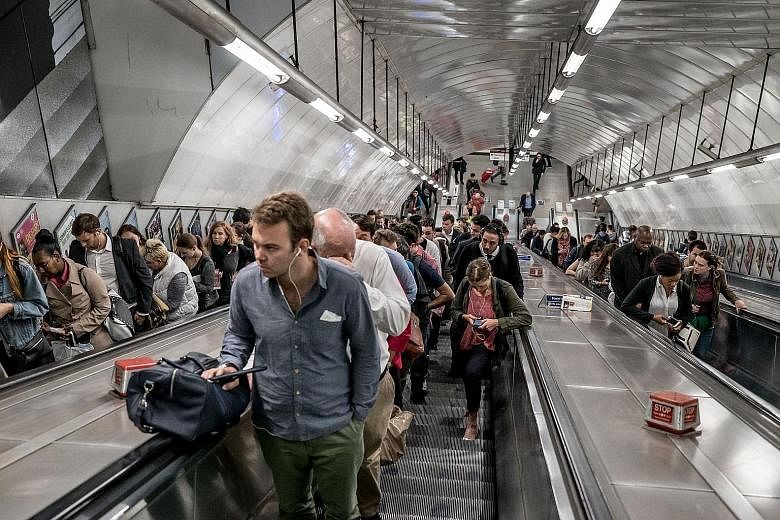LONDON • One of London's busiest and deepest underground stations is encouraging people at rush hour to stand side by side on the escalators going up instead of leaving the left side empty in an experiment to reduce congestion.
The science is simple: Fill the available space on the escalators with people, rather than leaving the left side of each step largely empty, except for the few who choose to march up the metal mountain.
A three-week trial at Holborn station last year found that standing on both sides of the escalator reduced congestion by about 30 per cent. During rush hour, about 16,220 people could travel on the escalators, compared with 12,745 in normal conditions.
The London Underground is chronically overcrowded, and annual ridership, already at 1.34 billion, has been increasing nearly 4 per cent a year.
Holborn station is one of London's busiest and deepest with more than 56 million passengers a year and escalators 23.4m tall.
The London Underground has now concluded that in stations with escalators more than 18.5m tall, much of the left side of the escalators goes unused, causing blockages and lines at the bottom.
A six-month trial has now been started at Holborn in April.
"It seems to be working better," said Mr Kieron Racher, a member of the Special Requirements Team for the London Underground. "We are slowly changing people's minds."
Mr Mark Evers, the customer strategy director for the London Underground, said results had been mixed, "as we expected at this stage".
With customer use increasing so fast, and given the depth of Holborn, it made sense to try the experiment during the morning and evening rush hours, he said, when the station is particularly hellish.
Holborn station, opened in 1906, serves a busy commercial and academic part of London, near the British Museum, the London School of Economics and Bloomsbury Square. Two major lines, the Piccadilly and the Central, pass through it.
During rush hour on many evenings, staff members limit the number of people who can enter the station, or they shut it entirely for up to 10 minutes at a time because the escalators and platforms are packed.
Today, screens at the bottom of the escalators show a looped video of a neatly uniformed woman from the staff advising people to stand on both sides. There are signs on the floors; painted footsteps on both sides of the escalator stairs; electronic versions of triangular "stand on the right" signs; and, of course, station announcements that are difficult to hear through an inadequate loudspeaker system.
But the Underground has also, cleverly, left a third escalator - on the far left, of course - for anyone to ride or climb as he or she pleases, so in some sense it is stepping heaven, without any official hectoring.
NEW YORK TIMES

